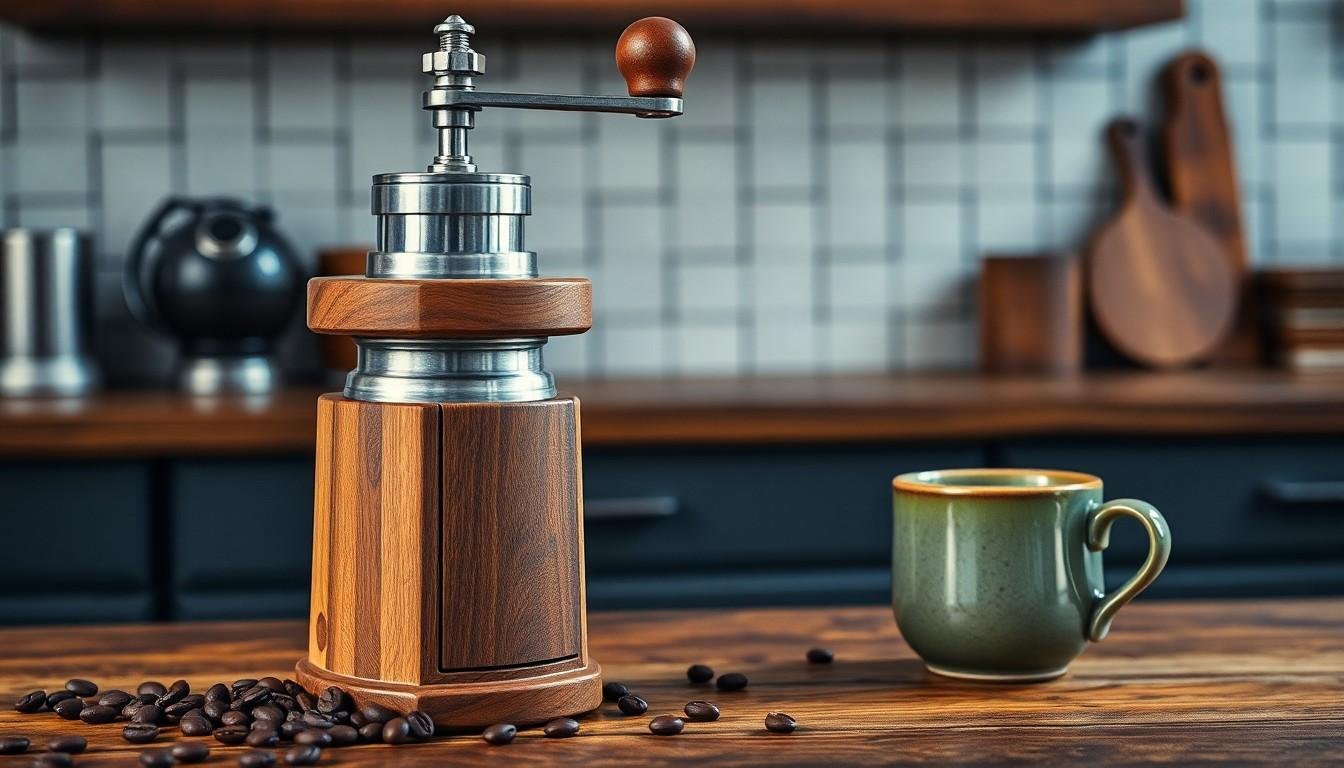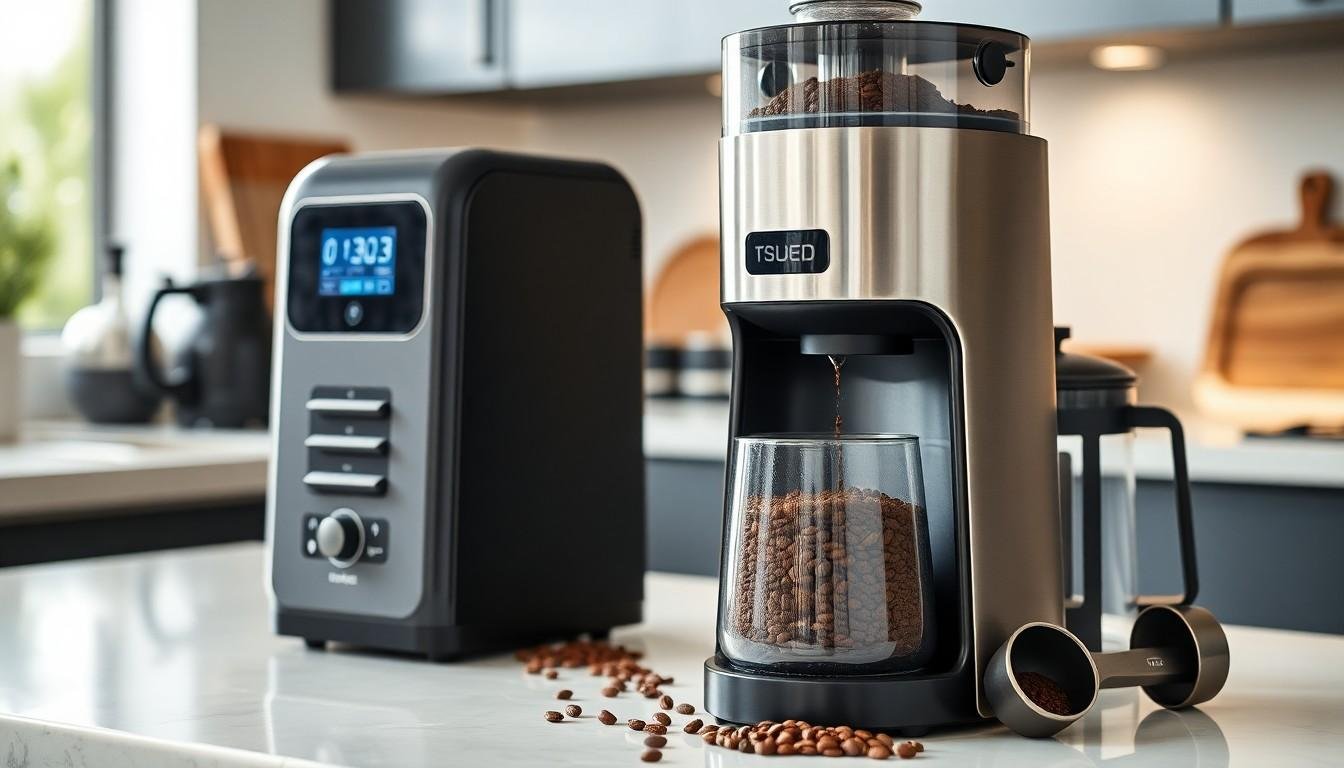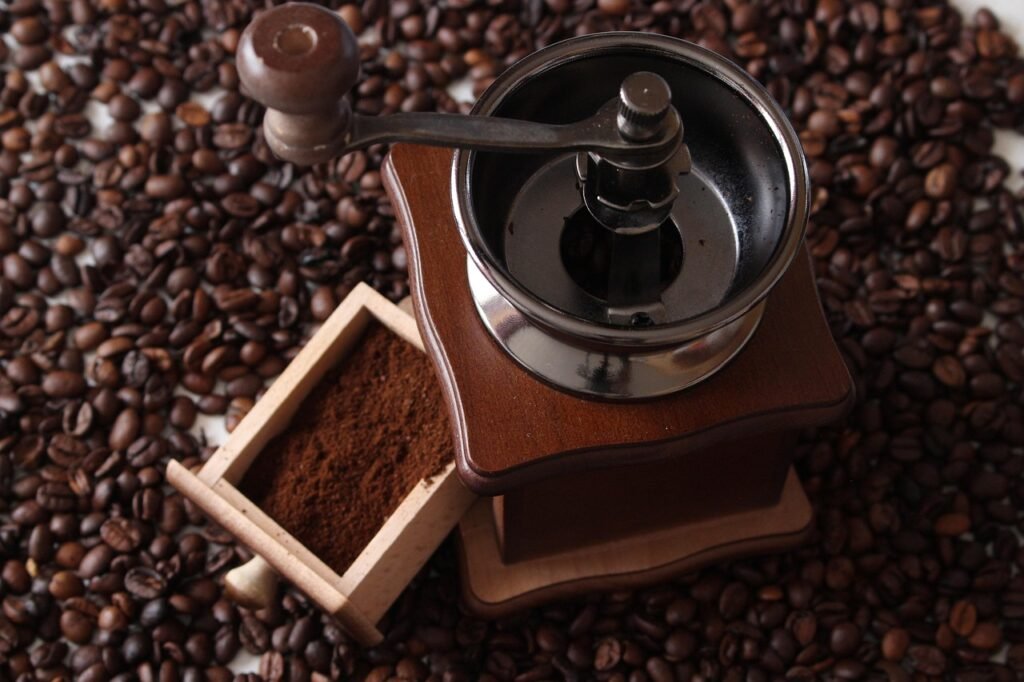
Artisanal Rituals for a Memorable Customer Experience
How can brands create a more balanced and memorable customer experience by blending artisanal product quality with thoughtful everyday rituals that keep people coming back?

Wondering which is right for you? Our comparison of manual vs electric coffee grinders breaks down what matters most: flavor, convenience, and cost. The quest for perfect coffee begins with choosing the right grinding tool. Coffee enthusiasts often find themselves weighing the benefits of each option—two distinctive approaches that significantly impact taste, consistency, and your overall brewing experience. Let’s explore which grinder might be your perfect match and help elevate your morning brew!
Manual grinders offer portability, affordability, and a hands-on approach that many coffee purists appreciate. Electric models, meanwhile, provide convenience, speed, and often more grinding options. The choice between these two styles isn’t merely about preference; it involves considerations of noise level, grind consistency, price point, and even how the grinding method affects the coffee’s aromatic properties.
This comprehensive comparison explores the key differences between manual and electric coffee grinders, helping coffee lovers make an informed decision that aligns with their brewing habits, lifestyle needs, and flavor expectations.
Of course, even the finest grinder needs quality beans to produce exceptional coffee. For those seeking premium coffee beans to complement their grinding equipment, Equipoise Coffee offers a selection of expertly sourced and roasted options that bring out the best in any brewing method. Check out their collection at Equipoise Coffee.
Coffee grinders transform whole beans into grounds suitable for brewing. The process of grinding affects extraction rates and ultimately impacts flavor profiles in the cup. Two main types dominate the market: manual and electric grinders, each offering distinct advantages for different brewing scenarios.
Manual grinders operate through hand-powered mechanisms where users turn a crank to process beans. These traditional tools connect users to the brewing process with their tactile nature. Manual models feature precision burrs that ensure consistent particle size despite their compact designs.
Electric grinders utilize motors to automate the grinding process. These machines process beans quickly with minimal physical effort, making them popular for daily use in busy households. High-end electric models offer multiple grind settings for everything from espresso to French press.
The key components in quality grinders include:
Grind consistency directly influences extraction quality. Uniform particles extract at similar rates, creating balanced flavors, while inconsistent grounds produce uneven extraction resulting in bitter or sour notes. The degree of fineness ranges from powdery (Turkish coffee) to coarse (cold brew), with each brewing method requiring specific particle sizes for optimal results.

Manual coffee grinders offer a hands-on approach to coffee grinding that appeals to enthusiasts who value craftsmanship and control. These hand-powered devices deliver a sensory experience that connects users to the brewing process while providing practical advantages over their electric counterparts.
Manual coffee grinders feature thoughtful construction with durable materials like stainless steel, ceramic, and hardwood that enhance longevity and performance. Their compact, cylindrical shape typically houses a central shaft with burrs at one end and a hand crank at the other. Premium models incorporate ergonomic handles and anti-slip grips to reduce hand fatigue during extended grinding sessions. The simplicity of manual grinders eliminates complex electrical components, resulting in fewer potential failure points. Their portable design makes them ideal for travel, camping, or office use, fitting easily into backpacks or kitchen drawers. Many coffee enthusiasts appreciate the aesthetic appeal of manual grinders, with wooden accents and brass details that complement contemporary kitchen decor.
Manual coffee grinders deliver exceptional grind consistency when equipped with quality burrs. High-end manual models utilize precision-engineered conical or flat burrs that produce uniform particle sizes across various grind settings. This consistency leads to balanced extraction and flavor development during brewing. The slower grinding process generates less heat than electric alternatives, preserving volatile aromatic compounds in the coffee beans. Users maintain complete control over grinding speed, allowing for adjustments based on bean density and roast level. While manual grinding requires more time and effort, particularly for finer settings like espresso, the results justify the investment for many coffee enthusiasts. The stepped adjustment mechanisms in quality manual grinders enable precise setting changes, making them suitable for multiple brewing methods from French press to pour-over.
Manual coffee grinders offer exceptional value across various price points, ranging from entry-level models at $25 to premium options exceeding $250. Mid-range grinders ($50-$100) typically provide the best balance of quality and affordability for most home brewers. The durability of manual grinders extends their lifespan beyond many electric counterparts, often functioning reliably for decades with minimal maintenance. Their mechanical simplicity eliminates costly electronic repairs or replacements, resulting in lower long-term ownership costs. Higher-end manual grinders feature premium materials and precision-engineered components that justify their increased price through improved grind consistency and user experience. The absence of electricity requirements makes manual grinding more environmentally sustainable and energy-efficient compared to electric alternatives. For coffee enthusiasts seeking both quality and value, a well-constructed manual grinder represents an investment that delivers consistent results cup after cup.

Electric coffee grinders represent modern convenience in the coffee preparation process. These powerful machines automate grinding with the press of a button, offering efficiency for coffee lovers who prioritize speed and consistency in their daily brewing routine.
Electric grinders operate using motors that power burr or blade mechanisms to crush coffee beans. Most models feature straightforward interfaces with buttons or dials that control operation time and grind settings. High-end electric grinders include programmable timers, allowing users to set exact grinding durations for consistent results batch after batch. The automated process eliminates the physical effort required by manual grinders, making them ideal for households preparing multiple cups daily or coffee shops serving numerous customers.
Modern electric grinders incorporate smart features like overheating protection and automatic shutoff mechanisms that extend the lifespan of the motor. Some advanced models include anti-static features that reduce mess and improve cleanliness during the grinding process. The consistent RPM (rotations per minute) maintained by electric motors creates uniform particle size, a crucial factor in extraction quality.
Electric grinders excel in providing precise adjustability across brewing methods. Many models offer 40+ grind settings, enabling micro-adjustments that accommodate everything from fine espresso to coarse French press grinds. Digital displays on premium units show exact setting numbers, allowing users to record and replicate preferred settings for different coffee varieties.
The versatility extends to volume capability, with electric grinders typically holding 8-16 ounces of beans in their hoppers. This capacity suits both single-cup brewers and those preparing larger batches. Advanced models feature conical burrs that create uniform particles at all settings, crucial for balanced extraction in specialty brewing methods like pour-over or AeroPress. The consistency achieved with quality electric grinders brings out distinct flavor notes in single-origin beans, making them valuable tools for coffee enthusiasts exploring nuanced flavor profiles.
Electric coffee grinders span various price points reflecting their technology and performance capabilities. Entry-level models start around $50-100, offering basic functionality with fewer grind settings and simpler burr designs. Mid-range options ($100-300) represent the sweet spot for most home brewers, providing durable construction, reliable motors, and sufficient adjustment options for diverse brewing methods.
Premium electric grinders ($300-700+) incorporate commercial-grade components, precision engineering, and advanced features like digital interfaces and weight-based grinding. While the initial investment exceeds manual alternatives, electric grinders deliver value through time savings and consistency. Many quality electric models last 5-10 years with proper maintenance, making them cost-effective investments for serious coffee enthusiasts. Additionally, electric grinders with proper burr design minimize waste by creating uniform grounds that extract evenly, ultimately conserving premium coffee beans.
When evaluating coffee grinders, performance metrics reveal significant differences between manual and electric options. These differences impact your brewing results and overall coffee experience in several key ways.
Grind consistency directly affects extraction quality and flavor clarity in your cup. High-end manual grinders with precision-engineered burrs often match or exceed mid-range electric models in particle size uniformity. Manual grinders produce remarkably consistent grounds due to their stabilized central shaft systems that minimize burr wobble. Electric grinders maintain consistency through controlled motor speeds, though budget electric models can struggle with heat generation that affects grind quality over time. Hand grinders excel with lighter roasts where clarity is paramount, while quality electric grinders handle all roast profiles with dependable results. For specialty coffee brewing where extraction precision matters, the stability of well-crafted manual grinders gives them a surprising edge despite their simpler mechanics.
Electric grinders dramatically outperform manual options in processing speed. A typical electric burr grinder processes 18-20 grams of coffee beans in 5-10 seconds, while manual grinding requires 1-2 minutes of continuous effort for the same amount. This efficiency becomes particularly valuable when preparing multiple servings. Electric models also maintain consistent grinding speeds regardless of bean density or roast level. Manual grinders demand varying levels of physical effort depending on bean hardness, with lighter roasts requiring significantly more force. For daily brewing routines or commercial settings, electric grinders clearly win the speed contest, though manual grinding offers a meditative ritual that some coffee enthusiasts appreciate as part of their brewing process.
Manual grinders operate with minimal noise, typically producing only 30-45 decibels during use – comparable to a quiet conversation. This subtle grinding sound makes them ideal for early morning brewing without disturbing sleeping household members. Electric grinders generate considerably more noise, ranging from 70-85 decibels (similar to a vacuum cleaner), with blade grinders producing sharper, more jarring sounds than burr models. Premium electric grinders incorporate sound dampening features that reduce noise to 65-70 decibels. The quiet operation of manual grinders accommodates noise-sensitive environments like apartments with thin walls or offices with shared spaces. For those prioritizing a peaceful coffee preparation ritual, manual grinders create a noticeably more serene experience while delivering excellent grind quality.

Your coffee grinder choice should align with your lifestyle and daily routine. Factors like available space, portability needs, and power accessibility directly impact which type of grinder integrates seamlessly into your coffee ritual.
Manual coffee grinders excel in space efficiency and portability. These compact devices typically measure 6-8 inches tall with a 2-3 inch diameter, fitting easily in kitchen drawers, backpacks, or travel bags. Their lightweight design—most weighing under 2 pounds—makes them ideal companions for camping trips, office use, or vacations. High-quality manual grinders like those crafted from stainless steel or aluminum provide durability without sacrificing portability.
Electric grinders demand more permanent counter space, with most models measuring 5-9 inches wide and 9-15 inches tall. Their weight ranges from 4-15 pounds, making them stationary appliances rather than travel companions. Kitchen setups with limited counter real estate might struggle to accommodate larger electric models, requiring dedicated space in the coffee preparation area.
Manual grinders operate without electricity, functioning perfectly in remote locations, during power outages, or in settings without accessible outlets. This independence makes them versatile tools for outdoor enthusiasts and travelers exploring areas with unreliable electricity. The human-powered mechanism provides complete control while eliminating dependence on external power sources.
Electric grinders require consistent access to power outlets, limiting their use to locations with reliable electricity. Most models operate on standard 110-120V circuits (US) and consume between 100-250 watts during operation. Some premium electric grinders feature advanced power management systems to optimize performance.

Manual grinders serve coffee enthusiasts who value connection to the brewing process and portability above all else. These grinders excel for individuals who:
The tactile experience offered by hand grinders creates a mindful morning ritual that many purists find enhances their appreciation of the final cup. Manual grinders operate silently, making them perfect for early risers sharing living spaces with others still sleeping.
Electric grinders match perfectly with coffee drinkers who prioritize efficiency and consistency for multiple cups. These grinders benefit users who:
Electric models deliver consistent results cup after cup with minimal effort. They’re particularly valuable for households where coffee preparation needs to fit within tight morning schedules or where multiple brewing methods require different grind profiles throughout the day.

Manual coffee grinders feature simpler construction with fewer parts, making them significantly easier to clean. Most models disassemble in under a minute, allowing access to all components for thorough cleaning. Users typically need to brush away coffee residue from the burrs and wipe down the chamber after each use. Deep cleaning involves removing the burrs and washing the non-metallic parts with mild soap and water once every 1-2 weeks.
Electric grinders require more meticulous maintenance due to their complex internal mechanisms. Many models come with dedicated cleaning brushes for removing coffee grounds from grinding chambers and chutes. Electrical components limit cleaning options—users can’t submerge the main unit in water. Instead, they must use dry brushes, compressed air, or specialized cleaning tablets. Some premium electric grinders feature removable burr assemblies that simplify the cleaning process, but most still demand 3-4 times more maintenance time than manual alternatives.
Manual grinders boast exceptional durability with minimal moving parts. High-quality manual models utilize ceramic or hardened steel burrs that maintain performance for 5-10 years of daily use. Their mechanical simplicity eliminates vulnerability to electrical failures, power surges, or motor burnout. The straightforward design means owners can easily replace individual components when needed, extending the grinder’s lifespan to 10+ years.
Electric grinders incorporate complex electrical systems, motors, and circuit boards alongside their grinding mechanisms. These additional components create multiple potential failure points, especially in humid environments or with frequent use. Quality electric models typically last 3-7 years before requiring significant repairs or replacement. Premium models feature modular designs with replaceable parts, but budget options often become disposable when electrical components fail.
The initial investment in a quality manual grinder ($75-200) typically results in lower lifetime costs. With minimal maintenance expenses and exceptional longevity, the per-cup cost decreases significantly over time. Manual grinders require no electricity, eliminating operational costs beyond the occasional replacement burr set every 5-7 years ($15-40).
Electric grinders demand higher initial investment ($150-500) plus ongoing electricity costs. They also incur more substantial maintenance expenses, including replacement parts, cleaning solutions, and potential repair costs. However, their time-saving benefits provide tangible value for heavy users, potentially offsetting the higher lifetime cost for those who prepare multiple cups daily.
The perfect coffee grinder balances personal preference with practical needs. Manual grinders deliver a tactile experience with excellent value and portability for purists and travelers. They’re quiet reliable companions that can last decades with minimal maintenance.
Electric grinders offer convenience and speed for busy households and entertainers seeking efficiency without sacrificing quality. While they require more space and maintenance their versatility across brewing methods makes them invaluable for many coffee enthusiasts.
Ultimately the choice depends on individual lifestyle factors: available space grinding volume desired experience and budget. Both options can produce exceptional results when matched appropriately to the user’s coffee journey and daily routine. Whichever grinder type you choose, pairing it with high-quality beans from Equipoise Coffee ensures you’ll experience the full potential of your brewing setup. Their carefully curated selection of specialty coffees complements both manual and electric grinding methods, delivering exceptional flavor profiles that true coffee lovers appreciate.
The main difference is the grinding mechanism: manual grinders require physical effort to operate a hand crank, while electric grinders use motorized burrs at the push of a button. Manual grinders offer portability, affordability, and a tactile connection to the brewing process, whereas electric grinders provide convenience, speed, and often more grind settings. Your choice depends on priorities like noise level, consistency, price, and lifestyle.
Grind consistency directly impacts extraction, which determines flavor. Uniform particle size ensures balanced extraction where water interacts evenly with all coffee grounds. Inconsistent grinds lead to both under and over-extraction simultaneously—fine particles release bitter compounds while coarse ones remain under-extracted and sour. High-quality grinders (manual or electric) with good burrs produce consistent grounds, resulting in cleaner, more distinct flavor profiles.
Yes, manual coffee grinders are highly portable. Their compact size, lightweight design, and independence from electrical power make them ideal travel companions. Most quality manual grinders are about the size of a water bottle and weigh less than a pound. They easily fit into backpacks, suitcases, or car compartments, allowing coffee enthusiasts to enjoy freshly ground beans while camping, traveling, or in office settings.
Manual coffee grinders generally last 10+ years with proper care due to their simple mechanical construction and durable materials like stainless steel burrs. Electric grinders typically last 3-7 years, with premium models reaching the upper end of that range. Regular cleaning and maintenance significantly extend the lifespan of both types. Manual grinders usually require less maintenance and have fewer parts that can fail.
Electric grinders are typically better for espresso due to their precise adjustment capabilities and consistent fine grinding. Quality espresso requires extremely fine, uniform grounds, which high-end electric grinders deliver more consistently. However, premium manual grinders with high-quality burrs and fine adjustment mechanisms can also produce espresso-grade grounds, though they require more time and effort. For serious espresso enthusiasts, specialized electric grinders remain the standard choice.
Yes, manual grinders are significantly quieter than electric models. Manual grinding produces minimal noise—usually just a soft crushing sound as beans break down. This makes manual grinders ideal for early mornings or shared living spaces. Electric grinders, conversely, generate considerable noise from their motors, often reaching disruptive decibel levels. Some premium electric models incorporate noise reduction features, but they still can’t match the near-silent operation of manual grinders.
For manual grinders, expect to spend $30-50 for entry-level models, $60-150 for mid-range options with steel burrs and better consistency, and $150-350 for premium versions with exceptional build quality. Electric grinders start around $50-100 for basic models, $150-300 for good mid-range grinders with conical burrs, and $300-1,000+ for high-end models with precision settings and durable components. Generally, investing in a better grinder yields more consistent results.
For beginners, a mid-range manual grinder ($60-150) or entry-level electric burr grinder ($100-200) is ideal. Manual grinders teach fundamentals of grind size while being affordable and forgiving. Electric burr grinders offer convenience with good consistency. Avoid blade grinders despite their lower price—they produce inconsistent grounds. Choose based on your priorities: if convenience matters most, go electric; if you enjoy the process and want value, choose manual.
For manual grinders, disassemble according to manufacturer instructions and clean with a brush, mild soap, and water. Dry thoroughly before reassembling. For electric grinders, unplug first, then remove and clean the hopper and grounds container. Use grinder cleaning tablets monthly by running them through the machine, then grind a small amount of coffee to remove residue. Both types benefit from regular cleaning every 1-2 weeks to prevent oil buildup and maintain performance.
While technically possible, it’s not recommended to use your coffee grinder for spices. Spices contain oils that can impart strong flavors and aromas to the grinder’s burrs, potentially affecting your coffee’s taste. If you must grind both, consider dedicated grinders for each purpose. If using one grinder for both, thoroughly clean it after grinding spices by running rice or grinder cleaning tablets through it to remove residual oils and aromas.

How can brands create a more balanced and memorable customer experience by blending artisanal product quality with thoughtful everyday rituals that keep people coming back?

Independent coffee shops have always been about more than caffeine—they’re hubs of creativity, connection, and care. As café culture continues to evolve, new trends are

Introduction Independent cafes win when they feel like the neighborhood’s living room and operate with the discipline of a great kitchen. Below is a quick

Discover how top specialty coffee brands create lasting loyalty through storytelling, sourcing, and community connection. Real tips from 6 industry experts.

Discover the ultimate showdown between two beloved coffee brewing methods: the French press and Chemex. Explore how each technique caters to distinct palates, with the French press delivering bold flavors and the Chemex presenting a bright, clean taste.

Unlock the secrets to brewing the perfect cup of coffee with our comprehensive guide on using a coffee scale. Discover how precise measurements enhance flavor and consistency while eliminating bitterness.

Discover how water temperature plays a vital role in brewing the perfect cup of coffee. This article delves into the ideal temperature range of 195°F to 205°F for optimal flavor extraction, enhancing the enjoyment of high-quality beans.

Discover the world of curated specialty coffee bundles, perfect for enthusiasts seeking quality and craftsmanship. This article explores the benefits of ethically sourced, small-batch beans from brands like Equipoise Coffee, offering diverse flavor profiles that elevate your brewing experience.

Discover the art of manual brewing to elevate your coffee experience! This article explores various techniques like pour-over, French press, and AeroPress, revealing how they enhance flavor and your connection to every cup.